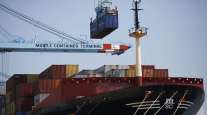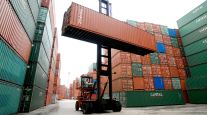Intermodal Freight Volumes Remain Strong, Contributing to Strong 3Q Railroad Profits
This story appears in the Oct. 25 print edition of Transport Topics.
The intermodal business is making a solid contribution to third-quarter rail profits, as volumes remain strong through the fall peak season for domestic freight, industry officials said.
Union Pacific Corp. said its third-quarter intermodal revenue jumped 34% to $880 million from a year earlier, helping the largest freight railroad to increase its net income by 51% to $778 million, or $1.56 a share. Intermodal shipments rose 24%, as rates for that freight increased 9.5%.
Likewise, CSX Corp. reported that its third-quarter intermodal volume rose 19%, including a 43% increase in international shipments. That gain helped the railroad to raise its third-quarter profit 43% above the same quarter of last year to $414 million, or $1.08 a share.
“We see opportunities for continued price growth in both our international and domestic lines of intermodal business,” said Clarence Gooden, chief commercial officer at CSX Corp.
Intermodal operating income rose 22% at J.B. Hunt Transport Services Inc. to $60.3 million, as revenue rose 23% to $559 million.
North American intermodal shipments totaled 3.64 million in the quarter, matching 2008 pre-recession levels and rising 18% from the 2009 third quarter.
Several other freight railroads are scheduled to report earnings this week.
Norfolk Southern, which boosted third-quarter intermodal volume 16%, is expected to raise quarterly earnings 35% to $409 million, based on an analyst survey.
Likewise, Canadian National Railway, which has extensive U.S. trackage, is expected to report it increased intermodal by 20% and boosted quarterly profit by 20%.
“Unlike some truckload carriers that already have reported earnings, we experienced strong demand through September, which has carried through to October,” said David Yeager, CEO of logistics company Hub Group Inc., where intermodal volume accounts for nearly 80% of revenue. Hub’s profits rose 28% to $12.6 million and revenue rose 33%.
“We do not get any indication that peak season will end early or that demand after peak season will be lower than normal,” Yeager said.
“While domestic trucking trends have weakened into September and October, intermodal volumes are experiencing more ‘normal’ seasonal demand improvement,” said a note by Robert W. Baird analyst Jon Langenfeld.
He estimated that intermodal rates are 10% to 15% below truck prices.
“Truck rates are the ceiling under which intermodal can operate,” said Larry Gross, who heads Gross Transportation Consulting and who also is a former intermodal executive. “As truck rates continue to move up, which we expect they will, that will help intermodal.”
On an absolute basis, intermodal shipments in August were 2% above September, according to the Association of American Railroads.
“There was quite a bit of disruption earlier in the year from both a shortage of ship and container capacity,” Gross said, which caused international shippers to ship earlier than normal to avoid delays.




